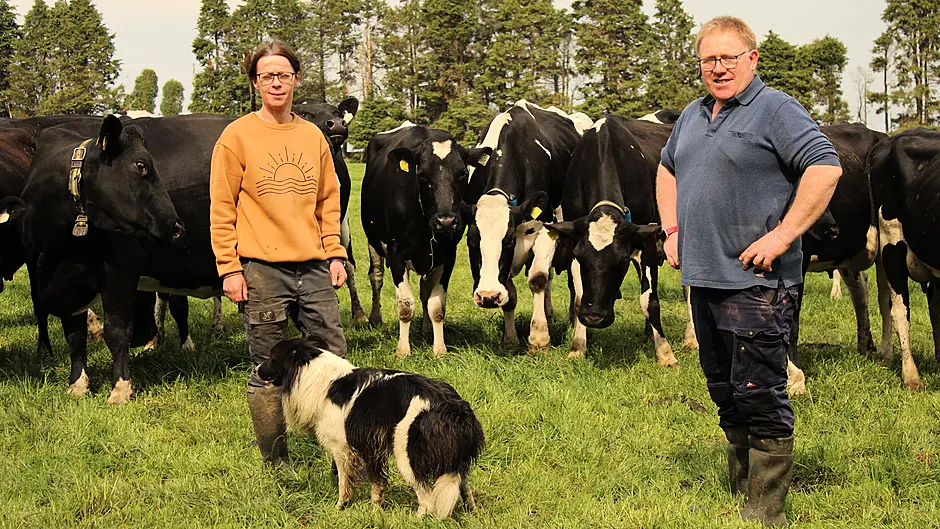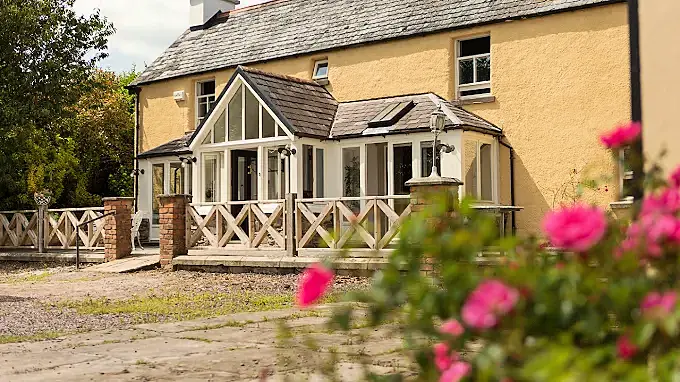A thirst for knowledge, new skills and diversification are key to the success of a third-generation family farm near Coachford
BY ANTHONY DINEEN
GERARD Buckley and his wife Gretta are farming near Coachford in the beautiful Lee Valley. They have two sons and three daughters. Gerard is the third generation of Buckleys on this farm – his grandfather having purchased the farm in the early 1920s, his father took over in the early 1960s and Gerard took the reins in 1997.
The farm has changed and developed significantly over the years. When Gerard took over, there were 67 cows, all progeny were finished off the farm and quota was a big restraint. In 2025, there were 185 cows calved down, which are predominantly Holstein-Friesian with the odd Jersey cross.
A lot of effort has gone in over the years to maximise output from the herd. The farm uses the AgriNet HerdApp to record all events, and ICBF Sire Advice for breeding. Since 2021 they have been using SenseHub heat and health monitoring collars with great results.
In 2024, the herd produced an average of 6,500 litres of milk per cow with 4.83% fat and 3.78% protein. Good fertility is very important, and the herd has an EBI of 250. Sexed semen is used to produce replacements and this spring all Friesian heifer calves were born by February 19th. The rest of the cows are inseminated to Belgian Blue, or Angus for the smaller cows.
Surplus heifers and all beef calves are sold. In 2001, a 16-unit milking parlour was built and this was expanded to 24 units in 2020. Cows are fed to yield in the parlour. High yielding cows are rewarded and condition score can be managed.
Vicky Kelleher is a full-time member of the farm team and has been working at Laharn for over 21 years. Continually learning is important to Vicky and she has acquired many new skills over the years, including grass measuring, and DIY AI. She has completely embraced the digital technology used to monitor the herd.
Recently both Gerard and Vicky completed hoof paring, breeding and scanning courses with Dunmasc Genetics and so far they have found their learnings very useful. They believe that every day is a school day and continually learning new skills and acquiring knowledge keeps everyone fresh and enthusiastic.
Biodiversity and nature are important to Gerard, as they were to his parents before him. Over the years many actions have been taken to enhance the biodiversity on the farm. Old stone walls around fields have been preserved and maintained. Thousands of trees and hundreds of metres of hedges have been planted. Gerard really appreciates what they add to the ecosystem as well as the appearance of his farm.
The farm is also in the ACRES scheme and some of the actions carried out here are:
- Riparian margins where watercourses are fenced off.
- Bird and owl boxes were erected.
- A new biodiversity pond was developed in 2021.
- Three bee hives were installed.
- An orchard was planted.
- More trees and hedges were planted.
In 2023, Gerard successfully applied for the Traditional Farm Building Grant Scheme from the Heritage Council. He restored an old stone lofted barn using lime plaster and traditional materials. The building was in bad repair and is now as good as the day it was built. Even though the farm embraces new technology, he feels it’s important to respect the local heritage and history.
Over the years they have reduced the chemical nitrogen being used on the farm. In 2024 there was less than 150kg/Ha used. Getting good soil fertility is an integral part of this and soil tests are taken every two years. There is a big emphasis on lime and in the last two years there has been 300 tonnes spread on the farm. Phosphorus levels on the farm are good and as a result this farm has no P allowance.
Slurry is used wisely on-farm and all slurry is spread using low-emission spreading methods. Potash levels on the silage ground is low. Sulphate of potash has been spread there and compound fertiliser 29:0:15 is being used on low potash fields.
Clover is also being used to reduce the chemical nitrogen required on this farm. The white clover in the grazing fields did well in 2023 but in 2024 did not do as well. As a result, 14 units/acre was spread to boost grass growth.
Red clover was also sown on this farm. There were 35 acres planted in 2022. It worked very well for two years but the amount of red clover in sward has gone down in some paddocks since then. Some paddocks that were not cut late in the year and that carried a big cover over the winter resulted in substantially less red clover levels the following year. Also, Gerard really stresses the importance of having weeds sorted before incorporating clover or mixed species.
The farm continues to develop. They have recently installed 23kw of solar panels and 25kw of battery on the farm. Gerard feels it’s a shame that the ESB network limits farms potential for microgeneration and believes this is a lost opportunity in meeting our climate targets and contributing towards farm incomes. They have plans to develop additional slurry storage on the farm.
The Buckleys run a farmhouse airbnb known as ‘The Old Farmhouse at Laharn Dairy’. This is very busy and attracts guests from all over the world who are keen to see farming up close.
In Gerard’s opinion, the future of farming is good. He believes that farmers need to work in harmony with the environment, be aware of what the customer wants and be the green and healthy option.
‘This is a family farm. It’s not too many industries where you get the privilege of working with your parents and siblings, and later with your children. This farm has been in the family for over 100 years and with continuous development hopefully will continue for many generations to come,’ Gerard concluded.
• Anthony Dineen is a Climate and Sustainability advisor in Cork West region and based in Teagasc advisory office Macroom.










